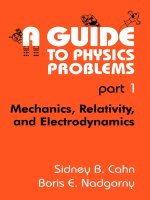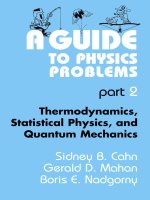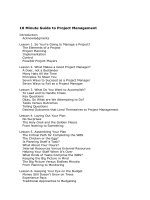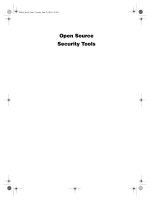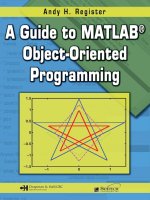- Trang chủ >>
- Khoa Học Tự Nhiên >>
- Vật lý
A guide to physics problems part 1 (2)
Bạn đang xem bản rút gọn của tài liệu. Xem và tải ngay bản đầy đủ của tài liệu tại đây (7.25 MB, 350 trang )
www.pdfgrip.com
A GUIDE
TO PHYSICS
PROBLEMS
part 1
Mechanics, Relativity,
and Electrodynamics
www.pdfgrip.com
This page intentionally left blank
www.pdfgrip.com
part 1
Mechanics, Relativity,
and Electrodynamics
Sidney B. Cahn
Boris E. Nadgorny
State University of New York at Stony Brook
Stony Brook, New York
KLUWER ACADEMIC PUBLISHERS
NEW YORK, BOSTON, DORDRECHT, LONDON, MOSCOW
www.pdfgrip.com
eBook ISBN:
Print ISBN:
0-306-48400-5
0-306-44679-0
©2004 Kluwer Academic Publishers
New York, Boston, Dordrecht, London, Moscow
Print ©1994 Kluwer Academic/Plenum Publishers
New York
All rights reserved
No part of this eBook may be reproduced or transmitted in any form or by any means, electronic,
mechanical, recording, or otherwise, without written consent from the Publisher
Created in the United States of America
Visit Kluwer Online at:
and Kluwer's eBookstore at:
www.pdfgrip.com
Foreword
For many graduate students of physics the written qualifying examination is the last and one of the most important of the hundreds of grueling
examinations that they have had to take in their career. I remember vividly
my own experience in 1947 at the University of Chicago. After the qualifying examination, I knew I was finally free from all future examinations,
and that generated a wonderful feeling of liberation and relief.
Be that as it may, the written qualifying examination does serve a useful
purpose, both for the faculty and for the students themselves. That is why
so many universities give these exams year after year in all parts of the
world.
Sidney Cahn and Boris Nadgorny have energetically collected and presented solutions to about 140 problems from the exams at many universities
in the United States and one university in Russia, the Moscow Institute
of Physics and Technology. Some of the problems are quite easy, others
quite tough; some are routine, others ingenious. Sampling them I am reminded of the tripos questions of Cambridge University that I had spent so
many hours on when I was an undergraduate student in China during the
years 1938–1942, studying such books as Whittaker’s Analytical Dynamics,
Whittaker and Watson’s Modern Analysis, Hardy’s Pure Mathematics, and
Jeans’ Electricity and Magnetism.
It is perhaps interesting to the readers of this volume to note that the
famous Stokes’ theorem, so important to modern differential geometry and
to physics, first appeared in public as problem No. 8 of the Smith Prize
Examination of 1854. Stokes was the examiner and Maxwell was one of the
takers of the examination. That Maxwell was impressed with this theorem,
and made extensive use of it in 1856 in the first of his epoch-making series
v
www.pdfgrip.com
FOREWORD
vi
of papers that led to Maxwell’s equations, is obvious from his papers and
from his A Treatise on Electricity and Magnetism (1873). Maybe a hundred
years from now somebody will remember one of the problems of the present
collection?
C.N. Yang
Stony Brook
www.pdfgrip.com
Preface
The written qualifying examination, a little publicized requirement of
graduate physics programs in most universities, brings some excitement to
the generally dull life of the graduate student. While undergoing this ordeal
ourselves, we were reminded of the initiation ceremonies into certain strict
monastic orders, designed to cause the novices enough pain to make them
consider their vocation seriously. However, as the memory of the ghastly
experience grows dim, our attitudes are gradually changing, and we now
may agree that these exams help assure a minimal level of general physics
knowledge necessary for performing successful research. Still, the affair
is rather stressful, sometimes more a test of character than of knowledge
(see Figure P.1). Perhaps it is the veteran’s memory of this searing, yet
formative experience that preserves the Institution of the Qualifying Exam.
Some schools do not have written exams, for instance: Brown, CalTech, Cornell, Harvard, UT Austin, Univ. of Toronto, Yale. However, the
majority do administer them and do so in a more or less standard form,
though, the level of difficulty of the problems, their style, etc., may differ
substantially from school to school. Our main purpose in publishing this
book — apart from the obvious one to become rich and famous — is to
assemble, as far as possible, a universal set of problems that the graduate
student should be able to solve in order to feel comfortable and confident at
the exam. Some books containing exam problems from particular universities (Chicago, Berkeley, Princeton) have been published; however, this is
the first book to contain problems from different American schools, and for
comparison, problems from Moscow Phys-Tech, one of the leading Russian
universities.
vii
www.pdfgrip.com
viii
PREFACE
The other goal of the book is much more complicated and only partly
realized: to allow comparison of problems from different schools in terms of
breadth of material, style, difficulty, etc. This would have required analysis
of a greater number of problems than we were able to include, and the
use of approximately the same number of problems from each department
(we had only a few problems from some universities and hundreds from
others). We were much more concerned to present problems that would
cover as much material as possible. We should note in this regard that
the exams with the most difficult problems to solve are not necessarily the
most difficult to pass — that depends on the number of problems that have
to be solved, the amount of time given for each problem, and the way in
which the problems are graded. We have not attempted to present such
information, but we wish to point out that it is an important consideration
in the selection of a graduate school and well worth investigating.
Quite often the written exam consists of two parts: the first part, covering “fundamental” physics, usually includes classical mechanics, electrodynamics, quantum mechanics, statistical physics and thermodynamics, and
www.pdfgrip.com
PREFACE
ix
sometimes special relativity and optics; the second part, containing “modern” physics, includes nuclear, atomic, elementary particle, and solid state
physics, and sometimes general relativity and astrophysics. The scope and
difficulty of the second part vary too much from school to school to allow
generalization, and we will only deal with the first part. The problems will
appear in two volumes: Part 1 — Mechanics, Relativity, and Electrodynamics, and Part 2 — Quantum Mechanics and Statistical Physics.
While reviewing the material submitted to us, we were not surprised to
find that often the same problems, maybe in slightly different formulations,
were part of the exams at several schools. For these problems, we have
noted the name of the school whose particular version we solved next to
the name we assigned to the problem, followed by the name or names of
schools whose exams contained variants of the problem. If only part of
the problem was used at a different school, we have indicated which one.
We have also tried to establish a balance between standard problems that
are popular with many physics departments and more original problems,
some of which we believe have never been published. Many of the standard
problems used in the exams have been published previously. In most cases,
though, it is difficult to determine when the problem was first presented;
almost as difficult as it is to track down the origin of a fairy tale. However,
when we could refer to a standard textbook where the problem may be
found, we have done so. Although it may be boring to solve a lot of the
standard problems, it is worthwhile – usually they comprise more than half
of all the problems given in the exams. We have to acknowledge grudgingly
that all errors in the formulation of the problems and solutions are the
sole responsibility of the authors. We have tried to provide solutions that
are as detailed as possible and not skip calculations even if they are not
difficult. We cannot claim that we have the best possible solutions and
inevitably there must be some errors, so we would welcome any comments
or alternative solutions from the reader.
We were encouraged by the response from most of the schools that we
approached, which furnished us with problems for inclusion in this book.
We would like to take this opportunity to thank the Physics Departments at
Boston University (Boston), University of Colorado at Boulder (Colorado),
Columbia University [Applied Physics] (Columbia), University of Maryland (Maryland), Massachusetts Institute of Technology (MIT), University of Michigan (Michigan), Michigan State University (Michigan State),
Michigan Technological University (Michigan Tech), Princeton University
(Princeton), Rutgers University (Rutgers), Stanford University (Stanford),
State University of New York at Stony Brook (Stony Brook), University of
Wisconsin (Wisconsin-Madison). The problems from Moscow Institute of
Physics and Technology (Moscow Phys-Tech) came from different sources
www.pdfgrip.com
x
PREFACE
— none from graduate qualifying exams, rather from undergraduate exams,
oral exams, and magazines (Kvant). A few were published before, in a book
containing a lot of interesting problems from Moscow Phys-Tech, but most
were compiled by the authors. We wish to thank Emmanuel I. Rashba, one
of the authors of that book, for his advice. We realize that there are many
schools which are not represented here, and we welcome any submissions
for Part 2 of this project.
It is our pleasure to thank many members of the Department of Physics
at Stony Brook for their encouragement during the writing of this book,
especially Andrew Jackson, Peter Kahn and Gene Sprouse, as well as Kirk
McDonald of Princeton. We are indebted to Chen Ning Yang, who agreed
to write the foreword for this book. We are grateful to: Dmitrii Averin,
Fabian Essler, Gerald Gwinner, Sergey Panitkin, Babak Razzaghe-Ashrafi,
Sergey Shokhor and Henry Silsbee for numerous discussions of problems
and many useful suggestions, and especially to Bas Peeters, who read most
of the manuscript; and to Michael Bershadsky, Claudio Corianò, and Sergey
Tolpygo for contributing some of the problems. One of the authors (B.N.)
wishes to thank the students at Oxford University and Oxford’s Student
Union for their invaluable help without which this book might not have been
written. Finally, we would like to thank Vladimir Gitt and Yair Minsky for
drawing the humorous pictures, and Susan Knapp for typing part of the
manuscript.
Sidney B. Cahn
Boris E. Nadgorny
Stony Brook
www.pdfgrip.com
Textbooks Used in the
Preparation of This Volume
Chapter 1
An exhaustive bibliography may be found in Goldstein.
1) Landau, L.D., and Lifshitz, E.M., Mechanics, Volume 1 of Course of
Theoretical Physics, 3rd ed., Elmsford, New York: Pergamon Press,
1976
2) Goldstein, H., Classical Mechanics, 2nd ed., Reading, MA: AddisonWesley, 1981
3) Barger, V.D., and Olsson, M.G., Classical Mechanics, A Modern Perspective, New York: McGraw-Hill, 1973
4) Routh, E., Dynamics of a System of Rigid Bodies, New York: Dover,
1960
5) Arnold, V. I., Mathematical Methods of Classical Mechanics, 2nd ed.,
New York: Springer-Verlag, 1978
6) Landau, L.D., and Lifshitz, E.M., Fluid Mechanics, Volume 6 of
Course of Theoretical Physics, 2nd ed., Elmsford, New York: Pergamon Press, 1987
Chapter 2
1) Taylor, E.F., and Wheeler, J.A., Spacetime Physics, San Francisco,
California: W.H. Freeman and Company, 1966
xi
www.pdfgrip.com
TEXTBOOKS
xii
2) Landau, L.D., and Lifshitz, E.M., Classical Theory of Fields, Volume
2 of Course of Theoretical Physics, 4th ed., Elmsford, New York:
Pergamon Press, 1975
3) Halzen, F., and Martin, A., Quarks and Leptons, New York: John
Wiley & Sons, Inc., 1984
4) Jackson, J.D., Classical Electrodynamics, New York: John Wiley &
Sons, Inc., 1975
Chapter 3
An exhaustive bibliography may be found in Jackson.
1) Jackson, J.D., Classical Electrodynamics, New York: John Wiley &
Sons, Inc., 1975
2) Landau, L.D., and Lifshitz, E.M., Classical Theory of Fields, Volume
2 of Course of Theoretical Physics, 4th ed., Elmsford, New York:
Pergamon Press, 1975
3) Landau, L.D., Lifshitz, E.M., and
L.P., Electrodynamics
of Continuous Media, Volume 8 of Course of Theoretical Physics, 2nd
ed., Elmsford, New York: Pergamon Press, 1984
4) Panofsky, W., and Philips, M., Classical Electricity and Magnetism,
2nd ed., Reading, MA: Addison-Wesley, 1962
5) Marion, J.B., and Heald, M.A., Classical Electromagnetic Radiation,
2nd ed., New York: Academic Press, 1980
6) Smythe, W.R., Static and Dynamic Electricity, 3rd ed., New York:
Hemisphere Publishing Corp., 1989
Note: CGS units are uniformly used in Chapter 3 for the purpose of consistency, even if the original problem was given in other units.
www.pdfgrip.com
PART I: PROBLEMS
l. Mechanics
3
1.1. Falling Chain (MIT, Stanford)
1.2. Cat and Mouse Tug of War (Moscow Phys-Tech, MIT)
1.3. Cube Bouncing off Wall (Moscow Phys-Tech)
1.4. Cue-Struck Billiard Ball (Rutgers, Moscow Phys-Tech, WisconsinMadison (a))
1.5. Stability on Rotating Rollers (Princeton)
1.6. Swan and Crawfish (Moscow Phys-Tech)
1.7. Mud from Tire (Stony Brook)
1.8. Car down Ramp up Loop (Stony Brook)
1.9. Pulling Strings (MIT)
1.10. Thru-Earth Train (Stony Brook, Boston (a), WisconsinMadison (a))
1.11. String Oscillations (Moscow Phys-Tech)
1.12. Hovering Helicopter (Moscow Phys-Tech)
1.13. Astronaut Tether (Moscow Phys-Tech, Michigan)
1.14. Spiral Orbit (MIT)
1.15. Central Force with Origin on Circle (MIT, Michigan State)
1.16. Central Force Orbit (Princeton)
1.17. Dumbbell Satellite (Maryland, MIT, Michigan State)
1.18. Yukawa Force Orbit (Stony Brook)
1.19. Particle Colliding with Reflecting Walls (Stanford)
1.20. Earth–Comet Encounter (Princeton)
xiii
www.pdfgrip.com
3
3
4
4
5
6
7
7
8
8
9
9
9
10
10
10
11
11
12
12
CONTENTS
xiv
1.21.
1.22.
1.23.
1.24.
1.25.
1.26.
13
13
13
14
14
1.27.
1.28.
1.29.
1.30.
1.31.
1.32.
1.33.
1.34.
1.35.
1.36.
1.37.
1.38.
1.39.
1.40.
1.41.
1.42.
1.43.
1.44.
1.45.
1.46.
1.47.
1.48.
1.49.
1.50.
1.51.
1.52.
1.53.
Neutron Scattering (Moscow Phys-Tech)
Collision of Mass–Spring System (MIT)
Double Collision of Mass–Spring System (Moscow Phys-Tech)
Small Particle in Bowl (Stony Brook)
Fast Particle in Bowl (Boston)
Mass Orbiting on Table (Stony Brook, Princeton, Maryland,
Michigan)
Falling Chimney (Boston, Chicago)
Sliding Ladder (Princeton, Rutgers, Boston)
Unwinding String (MIT, Maryland (a,b), Chicago (a,b))
Six Uniform Rods (Stony Brook)
Period as Function of Energy (MIT)
Rotating Pendulum (Princeton, Moscow Phys-Tech)
Flyball Governor (Boston, Princeton, MIT)
Double Pendulum (Stony Brook, Princeton, MIT)
Triple Pendulum (Princeton)
Three Masses and Three Springs on Hoop (Columbia, Stony Brook,
MIT)
Nonlinear Oscillator (Princeton)
Swing (MIT, Moscow Phys-Tech)
Rotating Door (Boston)
Bug on Globe (Boston)
Rolling Coin (Princeton, Stony Brook)
Unstable Top (Stony Brook)
Pendulum Clock in Noninertial Frame (Maryland)
Beer Can (Princeton, Moscow Phys-Tech)
Space Habitat Baseball (Princeton)
Vibrating String with Mass (Stony Brook)
Shallow Water Waves (Princeton (a,b))
Suspension Bridge (Stony Brook)
Catenary (Stony Brook, MIT)
Rotating Hollow Hoop (Boston)
Particle in Magnetic Field (Stony Brook)
Adiabatic Invariants (Boston (a)) and Dissolving Spring (Princeton,
MIT (b))
Superball in Weakening Gravitational Field (Michigan State)
2. Relativity
15
16
16
17
18
19
19
19
20
21
21
22
22
22
23
24
24
25
26
27
27
28
29
29
30
31
31
32
33
2.1. Marking Sticks (Stony Brook)
2.2. Rockets in Collision (Stony Brook)
www.pdfgrip.com
33
34
xv
CONTENTS
2.3.
2.4.
2.5.
2.6.
2.7.
2.8.
2.9.
2.10.
2.11.
2.12.
2.13.
2.14.
2.15.
2.16.
2.17.
2.18.
2.19.
Photon Box (Stony Brook)
Cube’s Apparent Rotation (Stanford, Moscow Phys-Tech)
Relativistic Rocket (Rutgers)
Rapidity (Moscow Phys-Tech)
Charge in Uniform Electric Field (Stony Brook, Maryland,
Colorado)
Charge in Electric Field and Flashing Satellites (Maryland)
Uniformly Accelerated Motion (Stony Brook)
Compton Scattering (Stony Brook, Michigan State)
Mossbauer Effect (Moscow Phys-Tech, MIT, Colorado)
Positronium and Relativistic Doppler Effect (Stony Brook)
Transverse Relativistic Doppler Effect (Moscow Phys-Tech)
Particle Creation (MIT)
Electron–Electron Collision (Stony Brook)
Inverse Compton Scattering (MIT, Maryland)
Proton–Proton Collision (MIT)
Pion Creation and Neutron Decay (Stony Brook)
Elastic Collision and Rotation Angle (MIT)
3.5.
3.6.
3.7.
3.8.
3.9.
3.10.
3.11.
3.12.
3.13.
3.14.
3.15.
3.16.
3.17.
37
37
38
38
39
39
39
40
40
40
40
41
41
43
3. Electrodynamics
3.1.
3.2.
3.3.
3.4.
34
35
36
36
Charge Distribution (Wisconsin-Madison)
Electrostatic Forces and Scaling (Moscow Phys-Tech)
Dipole Energy (MIT, Moscow Phys-Tech)
Charged Conducting Sphere in Constant Electric Field (Stony
Brook, MIT)
Charge and Conducting Sphere I (MIT)
Charge and Conducting Sphere II (Boston)
Conducting Cylinder and Line Charge (Stony Brook, Michigan
State)
Spherical Void in Dielectric (Princeton)
Charge and Dielectric (Boston)
Dielectric Cylinder in Uniform Electric Field (Princeton)
Powder of Dielectric Spheres (Stony Brook)
Concentric Spherical Capacitor (Stony Brook)
Not-so-concentric Spherical Capacitor (Michigan Tech)
Parallel Plate Capacitor with Solid Dielectric (Stony Brook,
Michigan Tech, Michigan)
Parallel Plate Capacitor in Dielectric Bath (MIT)
Not-so-parallel Plate Capacitor (Princeton (a), Rutgers (b))
Cylindrical Capacitor in Dielectric Bath (Boston, Maryland)
www.pdfgrip.com
43
43
44
44
45
45
46
46
47
47
48
48
49
49
50
51
51
xvi
CONTENTS
3.18.
3.19.
3.20.
3.21.
3.22.
3.23.
3.24.
3.25.
3.26.
3.27.
3.28.
3.29.
3.30.
3.31.
3.32.
3.33.
3.34.
3.35.
3.36.
3.37.
3.38.
3.39.
3.40.
3.41.
3.42.
3.43.
3.44.
3.45.
3.46.
3.47.
3.48.
3.49.
3.50.
3.51.
3.52.
3.53.
3.54.
3.55.
3.56.
3.57.
3.58.
Iterated Capacitance (Stony Brook)
Resistance vs. Capacitance (Boston, Rutgers (a))
Charge Distribution in Inhomogeneous Medium (Boston)
Green’s Reciprocation Theorem (Stony Brook)
Coaxial Cable and Surface Charge (Princeton)
Potential of Charged Rod (Stony Brook)
Principle of Conformal Mapping (Boston)
Potential above Half Planes (Princeton)
Potential of Halved Cylinder (Boston, Princeton, Chicago)
Resistance of a Washer (MIT)
Spherical Resistor (Michigan State)
Infinite Resistor Ladder (Moscow Phys-Tech)
Semi-infinite Plate (Moscow Phys-Tech)
Magnetic Field in Center of Cube (Moscow Phys-Tech)
Magnetic Dipole and Permeable Medium (Princeton)
Magnetic Shielding (Princeton)
Electromotive Force in Spiral (Moscow Phys-Tech)
Sliding Copper Rod (Stony Brook, Moscow Phys-Tech)
Loop in Magnetic Field (Moscow Phys-Tech, MIT)
Conducting Sphere in Constant Magnetic Field (Boston)
Mutual Inductance of Line and Circle (Michigan)
Faraday’s Homopolar Generator (Stony Brook, Michigan)
Current in Wire and Poynting Vector (Stony Brook, MIT)
Box and Impulsive Magnetic Field (Boston)
Coaxial Cable and Poynting Vector (Rutgers)
Angular Momentum of Electromagnetic Field (Princeton)
Plane Wave in Dielectric (Stony Brook, Michigan)
X-Ray Mirror (Princeton)
Plane Wave in Metal (Colorado, MIT)
Wave Attenuation (Stony Brook)
Electrons and Circularly Polarized Waves (Boston)
Classical Atomic Spectral Line (Princeton, Wisconsin-Madison)
Lifetime of Classical Atom (MIT, Princeton, Stony Brook)
Lorentz Transformation of Fields (Stony Brook)
Field of a Moving Charge (Stony Brook)
Retarded Potential of Moving Line Charge (MIT)
Orbiting Charges and Multipole Radiation (Princeton, Michigan
State, Maryland)
Electron and Radiation Reaction (Boston)
Radiation of Accelerating Positron (Princeton, Colorado)
Half-Wave Antenna (Boston)
Radiation (Stony Brook)
www.pdfgrip.com
52
52
53
54
54
55
56
56
56
57
57
58
59
59
60
60
60
61
61
62
62
62
63
63
64
65
65
66
67
67
67
68
69
69
70
70
71
72
72
73
73
xvii
CONTENTS
3.59. Stability of Plasma (Boston)
3.60. Charged Particle in Uniform Magnetic Field (Princeton)
3.61. Lowest Mode of Rectangular Wave Guide (Princeton, MIT,
Michigan State)
3.62. TM Modes in Rectangular Wave Guide (Princeton)
3.63. Betatron (Princeton, Moscow Phys-Tech, Colorado, Stony
Brook (a))
3.64. Superconducting Frame in Magnetic Field (Mascow Phys-Tech)
3.65. Superconducting Sphere in Magnetic Field (Michigan State,
Moscow Phys- Tech)
3.66. London Penetration Depth (Moscow Phys-Tech)
3.67. Thin Superconducting Plate in Magnetic Field (Stony Brook)
74
74
74
75
75
76
77
77
78
PART II: SOLUTIONS
l. Mechanics
1.1.
1.2.
1.3.
1.4.
1.5.
1.6.
1.7.
1.8.
1.9.
1.10.
1.11.
1.12.
1.13.
1.14.
1.15.
1.16.
1.17.
1.18.
1.19.
1.20.
1.21.
81
Falling Chain (MIT, Stanford)
Cat and Mouse Tug of War (Moscow Phys-Tech, MIT)
Cube Bouncing off Wall (Moscow Phys-Tech)
Cue-struck Billiard Ball (Rutgers, Moscow Phys-Tech, WisconsinMadison (a))
Stability on Rotating Rollers (Princeton)
Swan and Crawfish (Moscow Phys-Tech)
Mud from Tire (Stony Brook)
Car down Ramp up Loop (Stony Brook)
Pulling Strings (MIT)
Thru-Earth Train (Stony Brook, Boston (a), Wisconsin-Madison (a))
String Oscillations (Moscow Phys-Tech)
Hovering Helicopter (Moscow Phys-Tech)
Astronaut Tether (Moscow Phys-Tech, Michigan)
Spiral Orbit (MIT)
Central Force with Origin on Circle (MIT, Michigan State)
Central Force Orbit (Princeton)
Dumbbell Satellite (Maryland, MIT, Michigan State)
Yukawa Force Orbit (Stony Brook)
Particle Colliding with Reflecting Walls (Stanford)
Earth–Comet Encounter (Princeton)
Neutron Scattering (Moscow Phys-Tech)
www.pdfgrip.com
81
81
82
84
86
88
90
92
94
95
97
98
99
100
101
102
104
106
107
109
110
CONTENTS
1.22.
1.23.
1.24.
1.25.
1.26.
1.27.
1.28.
1.29.
1.30.
1.31.
1.32.
1.33.
1.34.
1.35.
1.36.
1.37.
1.38.
1.39.
1.40.
1.41.
1.42.
1.43.
1.44.
1.45.
1.46.
1.47.
1.48.
1.49.
1.50.
1.51.
1.52.
1.53.
xviii
Collision of Mass–Spring System (MIT)
Double Collision of Mass–Spring System (Moscow Phys-Tech)
Small Particle in Bowl (Stony Brook)
Fast Particle in Bowl (Boston)
Mass Orbiting on Table (Stony Brook, Princeton, Maryland,
Michigan)
Falling Chimney (Boston, Chicago)
Sliding Ladder (Princeton, Rutgers, Boston)
Unwinding String (MIT, Maryland (a,b), Chicago (a,b))
Six Uniform Rods (Stony Brook)
Period as Function of Energy (MIT)
Rotating Pendulum (Princeton, Moscow Phys-Tech)
Flyball Governor (Boston, Princeton, MIT)
Double Pendulum (Stony Brook, Princeton, MIT)
Triple Pendulum (Princeton)
Three Masses and Three Springs on Hoop (Columbia, Stony Brook,
MIT)
Nonlinear Oscillator (Princeton)
Swing (MIT, Moscow Phys-Tech)
Rotating Door (Boston)
Bug on Globe (Boston)
Rolling Coin (Princeton, Stony Brook)
Unstable Top (Stony Brook)
Pendulum Clock in Noninertial Frame (Maryland)
Beer Can (Princeton, Moscow Phys-Tech)
Space Habitat Baseball (Princeton)
Vibrating String with Mass (Stony Brook)
Shallow Water Waves (Princeton (a,b))
Suspension Bridge (Stony Brook)
Catenary (Stony Brook, MIT)
Rotating Hollow Hoop (Boston)
Particle in Magnetic Field (Stony Brook)
Adiabatic Invariants (Boston (a)) and Dissolving Spring (Princeton,
MIT (b))
Superball in Weakening Gravitational Field (Michigan State)
2. Relativity
111
112
114
117
118
119
120
122
125
128
129
131
133
135
137
139
141
142
143
145
147
148
149
153
154
157
160
161
163
165
168
169
171
2.1. Marking Sticks (Stony Brook)
2.2. Rockets in Collision (Stony Brook)
2.3. Photon Box (Stony Brook)
www.pdfgrip.com
171
172
173
xix
CONTENTS
2.4.
2.5.
2.6.
2.7.
2.8.
2.9.
2.10.
2.11.
2.12.
2.13.
2.14.
2.15.
2.16.
2.17.
2.18.
2.19.
Cube’s Apparent Rotation (Stanford, Moscow Phys-Tech)
Relativistic Rocket (Rutgers)
Rapidity (Moscow Phys-Tech)
Charge in Uniform Electric Field (Stony Brook, Maryland,
Colorado)
Charge in Electric Field and Flashing Satellites (Maryland)
Uniformly Accelerated Motion (Stony Brook)
Compton Scattering (Stony Brook, Michigan State)
Mössbauer Effect (Moscow Phys-Tech, MIT, Colorado)
Positronium and Relativistic Doppler Effect (Stony Brook)
Transverse Relativistic Doppler Effect (Moscow Phys-Tech)
Particle Creation (MIT)
Electron–Electron Collision (Stony Brook)
Inverse Compton Scattering (MIT, Maryland)
Proton–Proto n Collision (MIT)
Pion Creation and Neutron Decay (Stony Brook)
Elastic Collision and Rotation Angle (MIT)
3. Electrodynamics
3.1.
3.2.
3.3.
3.4.
3.5.
3.6.
3.7.
3.8.
3.9.
3.10.
3.11.
3.12.
3.13.
3.14.
3.15.
3.16.
3.17.
3.18.
175
176
177
178
181
184
186
187
188
189
190
190
192
193
194
197
201
Charge Distribution (Wisconsin-Madison)
Electrostatic Forces and Scaling (Moscow Phys-Tech)
Dipole Energy (MIT, Moscow Phys-Tech)
Charged Conducting Sphere in Constant Electric Field (Stony
Brook, MIT)
Charge and Conducting Sphere I (MIT)
Charge and Conducting Sphere II (Boston)
Conducting Cylinder and Line Charge (Stony Brook, Michigan
State)
Spherical Void in Dielectric (Princeton)
Charge and Dielectric (Boston)
Dielectric Cylinder in Uniform Electric Field (Princeton)
Powder of Dielectric Spheres (Stony Brook)
Concentric Spherical Capacitor (Stony Brook)
Not-so-concentric Spherical Capacitor (Michigan Tech)
Parallel Plate Capacitor with Solid Dielectric (Stony Brook,
Michigan Tech, Michigan)
Parallel Plate Capacitor in Dielectric Bath (MIT)
Not-so-parallel Plate Capacitor (Princeton (a), Rutgers (b))
Cylindrical Capacitor in Dielectric Bath (Boston, Maryland)
Iterated Capacitance (Stony Brook)
www.pdfgrip.com
201
201
202
203
204
206
207
208
210
211
214
216
218
220
222
225
226
228
CONTENTS
xx
Resistance vs. Capacitance (Boston, Rutgers (a))
Charge Distribution in Inhomogeneous Medium (Boston)
Green’s Reciprocation Theorem (Stony Brook)
Coaxial Cable and Surface Charge (Princeton)
Potential of Charged Rod (Stony Brook)
Principle of Conformal Mapping (Boston)
Potential above Half Planes (Princeton)
Potential of Halved Cylinder (Boston, Princeton, Chicago)
Resistance of a Washer (MIT)
Spherical Resistor (Michigan State)
Infinite Resistor Ladder (Moscow Phys-Tech)
Semi-infinite Plate (Moscow Phys-Tech)
Magnetic Field in Center of Cube (Moscow Phys-Tech)
Magnetic Dipole and Permeable Medium (Princeton)
Magnetic Shielding (Princeton)
Electromotive Force in Spiral (Moscow Phys-Tech)
Sliding Copper Rod (Stony Brook, Moscow Phys-Tech)
Loop in Magnetic Field (Moscow Phys-Tech, MIT)
Conducting Sphere in Constant Magnetic Field (Boston)
Mutual Inductance of Line and Circle (Michigan)
Faraday’s Homopolar Generator (Stony Brook, Michigan)
Current in Wire and Poynting Vector (Stony Brook, MIT)
Box and Impulsive Magnetic Field (Boston)
Coaxial Cable and Poynting Vector (Rutgers)
Angular Momentum of Electromagnetic Field (Princeton)
Plane Wave in Dielectric (Stony Brook, Michigan)
X-Ray Mirror (Princeton)
Plane Wave in Metal (Colorado, MIT)
Wave Attenuation (Stony Brook)
Electrons and Circularly Polarized Waves (Boston)
Classical Atomic Spectral Line (Princeton, Wisconsin-Madison)
Lifetime of Classical Atom (MIT, Princeton, Stony Brook)
Lorentz Transformation of Fields (Stony Brook)
Field of a Moving Charge (Stony Brook)
Retarded Potential of Moving Line Charge (MIT)
Orbiting Charges and Multipole Radiation (Princeton, Michigan
State, Maryland)
3.55. Electron and Radiation Reaction (Boston)
3.56. Radiation of Accelerating Positron (Princeton, Colorado)
3.57. Half-Wave Antenna (Boston)
3.58. Cerenkov Radiation (Stony Brook)
3.59. Stability of Plasma (Boston)
3.19.
3.20.
3.21.
3.22.
3.23.
3.24.
3.25.
3.26.
3.27.
3.28.
3.29.
3.30.
3.31.
3.32.
3.33.
3.34.
3.35.
3.36.
3.37.
3.38.
3.39.
3.40.
3.41.
3.42.
3.43.
3.44.
3.45.
3.46.
3.47.
3.48.
3.49.
3.50.
3.51.
3.52.
3.53.
3.54.
www.pdfgrip.com
231
233
234
235
237
238
240
241
243
244
245
246
247
248
250
252
252
254
255
256
257
258
259
260
263
265
267
268
271
273
274
277
278
280
281
283
285
287
288
290
292
xxi
CONTENTS
3.60. Charged Particle in Uniform Magnetic Field (Princeton)
3.61. Lowest Mode of Rectangular Wave Guide (Princeton, MIT,
Michigan State)
3.62. TM Modes in Rectangular Wave Guide (Princeton)
3.63. Betatron (Princeton, Moscow Phys-Tech, Colorado, Stony
Brook (a))
3.64. Superconducting Frame in Magnetic Field (Moscow Phys-Tech)
3.65. Superconducting Sphere in Magnetic Field (Michigan State,
Moscow Phys-Tech)
3.66. London Penetration Depth (Moscow Phys-Tech)
3.67. Thin Superconducting Plate in Magnetic Field (Stony Brook)
293
294
297
299
303
305
306
308
PART III: APPENDIXES
Approximate Values of Physical Constants
Some Astronomical Data
Other Commonly Used Units
Conversion Table from Rationalized MKSA to Gaussian Units
Vector Identities
Vector Formulas in Spherical and Cylindrical Coordinates
Legendre Polynomials
Rodrieues’ Formula
Spherical Harmonics
313
314
314
315
316
317
320
321
321
BIBLIOGRAPHY
323
www.pdfgrip.com
This page intentionally left blank
www.pdfgrip.com
A GUIDE
TO PHYSICS
PROBLEMS
part 1
Mechanics, Relativity,
and Electrodynamics
www.pdfgrip.com
This page intentionally left blank
www.pdfgrip.com




